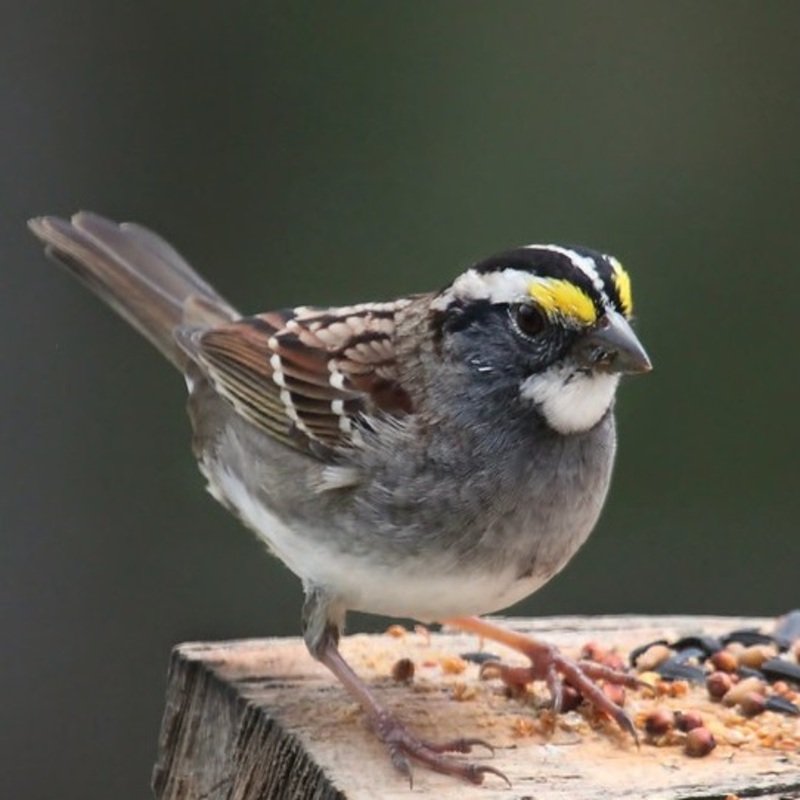Known to be called a white-throated sparrow, Zonotrichia albicollis belongs to the Passerellidae family of sparrows. The White-throated Sparrow is a widespread boreal breeding species that winters in eastern and southern North America. Its song is almost an anthem for the boreal region’s unspoiled wildness.
Quick Overview: Zonotrichia Albicollis – White-Throated Sparrow
Body size: Around 6.25-7.5 in (16-19 cm) and a weight of 26 g (.9 oz)
Main colors: Black, Brown, Gray, Yellow, White
Range: Eastern United States
Migratory Bird: Yes
Best time of the year to see in the U.S.: January, February, December
Conservation Status: Least Concern
White-throated sparrow Description
White-throated sparrows measure 16-19 cm. The top of the head is tan and black with gray and white below and on the sides. Adolescents have only tan, brown stripes with a heavily streaked underside, while adults have both. The male and female white-throated sparrows are sexually dimorphic. Males and females have slight color variations. Male sparrows have darker head stripes and yellower blotches.

Size
These birds have a length of 6.25-7.5 in (16-19 cm) and a weight of 26 g (.9 oz). Their wings could range 8.75-10 in (22-25cm).
Feeding
White-throated sparrow, like most Aves, is omnivorous. They eat seeds, fruits, and insects. Seeds grow on forest floors and bushy clearings. The white-throated sparrow hunts seeds in grasses and weeds. When available, they feed their young on insects and wild fruits from blackberry tangles, shrubbery, and shrubbery.
Habitat
White-throated sparrow inhabits northern coniferous and deciduous forests. In the winter, they can be found off-dry deserts. They prefer semi-open wooded areas with abundant shrubs or brushes. Himalayan blackberry tangles, forest edges, shrubby willows, and even densely brush-covered swamp borders attract white-throated sparrows.
Behavior
Seasonal migrants, white-throated sparrows visit North America twice a year. They often flock with other Zonotrichia sparrows, juncos, and occasionally house sparrows. In western Oregon, specifically the Klamath Basin, golden-crowned sparrows have been seen flocking with Zonotrichia albicollis. Zonotrichia albicollis nest in semi-open shrubby areas or forests, mostly in small trees or shrubs.
Zonotrichia albicollis Scientific Classification
- Kingdom: Animalia
- Phylum: Chordata
- Subphylum: Chelicerata
- Class: Aves
- Order: Passeriformes
- Family: Passerellidae
- Genus: Zonotrichia
- Species: Zonotrichia albicollis
Best time of the year to see
The best time to see these birds in the United States is during the winter season (December to February).
Distribution of the White-throated sparrow in the USA
During the summer, white-throated sparrows breed from northern Canada to New England, including Central Quebec and Newfoundland. Most white-throated sparrows spend the winter in the eastern United States, from New England to northern Mexico. A few Zonotrichia albicollis migrate to West Oregon, settling in the Columbia and Klamath River Basins.
The White-throated sparrow can be found in the following states in the United States – Connecticut, Delaware, Maine, Maryland, Massachusetts, New Hampshire, New Jersey, New York, North Carolina, Ohio, Pennsylvania, Rhode Island, South Carolina, Vermont, Virginia, and West Virginia
